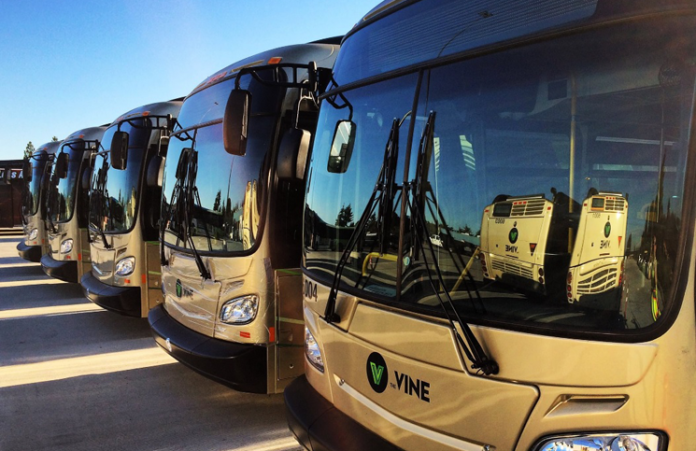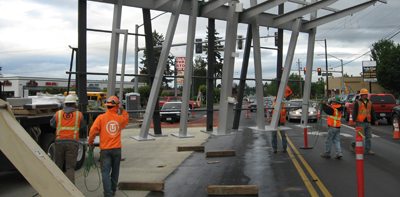This article has been updated to include new information about The Vine’s grand opening celebration.
Over the course of the past year, the installation of C-TRAN’s new bus rapid transit (BRT) line – known as The Vine – has brought construction activity to much of Vancouver’s Fourth Plain corridor. This month, with a final concrete pour and walkthrough inspections imminent, the end is finally in sight. And with a January 8 grand opening, Christine Selk, C-TRAN’s public affairs manager, says that the Vancouver community can look forward to a weekend full of activities and celebratory events.
The celebration will kick off with several guest speakers on Saturday, January 7, 12:30 p.m. at the new Vancouver Mall Transit Center. A street fair-style event will follow from 1 to 3 p.m. The public is invited to attend the celebration and ride along the corridor in one of the new 60-foot articulated buses that have become a hallmark of The Vine.
“As C-TRAN celebrates the opening of The Vine, and we reflect on the nearly six-year process to bring this project to fruition, we also want to celebrate our customers,” said Jeff Hamm, C-TRAN executive director/CEO. “Our riders are the reason we undertake any project, large or small. The Vine is designed to improve reliability, mobility and capacity on C-TRAN’s busiest corridor, getting people where they need to go quickly and efficiently. We believe it will change the face of public transit in Clark County and the region.”
Building the new BRT system has been a long process. C-TRAN began the initial planning phase in 2011, assessing the costs (which were covered largely by federal funds) and benefits of building such a system and working to determine which major corridor would be best-suited for the upgrade. It was not until the end of 2015 that the agency was finally ready to break ground and begin construction, and the process has been non-stop since then. Selk noted that building the new system has been a community process from beginning to end.
Three different construction companies have contracts for the three different segments of the BRT route that together form the Vine: the Fourth Plain corridor; the Vancouver Mall Transit Center relocation; and the upgrade of the maintenance facility at the C-TRAN campus.
Each contractor has a full crew and subcontractors working with them, resulting in work for hundreds of local residents over the course of the last year – though Selk added that it’s “nearly impossible” to estimate exactly how many people have been directly involved in the project since its inception in 2011.
The new system will replace outdated busses on C-TRAN’s highest ridership corridor and is expected to drastically improve transit efficiency by changing station design and bus type to both increase capacity and shorten the amount of time spent embarking and disembarking. According to a University of South Florida study, BRT systems on average require 11 percent less time waiting at stations for passengers to load and unload than non-BRT systems. The Vine’s new busses are 60-feet long accordion-style, which is a significant increase from the old 40-foot fixed models. Additionally, passengers can expect to board via a ramp from a raised platform.
The new busses will be able to carry more passengers without losing the maneuverability of the older busses with the new design. Under the old system, riders who were unable to use the default stairs had to wait for the driver to lower the bus, deploy a ramp, and often also help to secure chairs and scooters so that everyone could ride safely. The new design is intended to be much more accessible.
Selk pointed out that the new BRT system will be particularly helpful on the Fourth Plain corridor because nearly every bus on that corridor currently serves at least one person who uses a mobility aid.
“The number of riders that we have on that corridor along with the number of differently-abled customers that we serve, it will make a big difference,” she said. “It will help significantly.”
The new busses will cut back on time needed to assist mobility-impaired riders by making a ramp the default, rather than requiring drivers take a series of extra steps to assist.
Expanding The Vine
Officials at C-TRAN carefully considered community needs in developing a bus rapid transit system in Vancouver. In a 2012 study, the agency determined that the Fourth Plain corridor was the best place to begin upgrades, but Mill Plain and Highway 99 were also considered options for future expansion of the BRT system. Now that the Fourth Plain project is coming to a close, C-TRAN expects to revisit those expansion options in the coming years.
In fact, the C-TRAN Board of Directors is expected to vote this month on a budget that would allow the agency to revisit the results of the 2012 study and update it to reflect any changes that have come up since its completion. Selk said she anticipates the long range plan (known as C-TRAN 2030) will include some BRT expansion projects provided that any updates of the 2012 study demonstrate that further expansion would offer significant improvement for ridership and access along proposed routes.
Updating the 2012 study will involve re-evaluating a range of metrics including traffic patterns, demographic information and city planning elements, among other factors, Selk said. The study will also include analysis on why certain routes may offer greater community benefit than other routes, in order to ensure the best use of C-TRAN resources.
“It’s very thorough, very exhaustive,” said Selk, when asked about updating the 2012 study. The original study, she noted, took about one year to conduct.
“It’s been so interesting and rewarding to build this first one that it’s kind of cool to think about the next one and everything that’s going to go into that,” she added.
Learn more about The Vine at www.thevine.c-tran.com.





